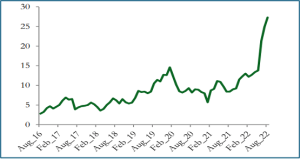Pakistan’s political and economic landscape is no stranger to upheavals.
At present, former prime minister Imran Khan’s party, Pakistan Tehreek-e-Insaf (PTI), faces corruption charges during the 2024 Pakistan general elections.
Meanwhile, Nawaz Sharif of the Pakistan Muslim League (Nawaz) (PML-N) stirred controversy by sporting a Gucci cap, allegedly worth more than 100,000 rupees (US$360), amid the country’s economic struggles.
Bilawal Bhutto Zardari, chairman of the Pakistan People’s Party (PPP), also grapples with past allegations of misgovernance and money laundering from 2018.
Beyond the political theatrics, the 2024 election is overshadowed by pressing financial challenges. With year-on-year inflation at 28% in January 2024, escalating fuel prices, and anticipated hikes in electricity bills, economic concerns dominate the campaign’s final stretch.
PML-N pledges to boost annual exports, finalize a US$10 billion oil-refinery deal with Saudi Arabia, and continue projects under the China-Pakistan Economic Corridor (CPEC). Simultaneously, PPP aims to double per capita income and provide free electricity to underprivileged families.
A fragile economic landscape
Pakistan’s economic predicament stems from a convergence of factors, including the global upheaval triggered by the Covid-19 pandemic, disruptions in global supply chains, and geopolitical tensions, especially the conflict between Ukraine and Russia.
This confluence has led to economic disarray marked by dwindling purchasing power, depleting foreign-exchange reserves, and escalating civil unrest.

The nation’s economic challenge is exacerbated by a significant decline in forex reserves. In early 2023, reserves hit a historic low of $3.19 billion, barely covering two weeks of imports and falling below the International Monetary Fund’s recommended three-month minimum.
Coupled with the daunting task of repaying a projected debt of $73 billion by 2025, including substantial portions owed to China and Saudi Arabia, Pakistan faces a precarious situation.
The dramatic devaluation of the Pakistani rupee further complicates matters. From hopes of becoming the world’s best-performing currency in October 2022 to hitting a record low in February 2023, the devaluation has far-reaching implications, impacting such essential imports as fuel, edible oil, and pulses.
Additionally, Pakistan’s gray-listing by the Financial Action Task Force (FATF) has significant economic implications, with estimated GDP losses since 2008 reaching $38 billion. While the country’s exclusion from the list in October 2022 provided some relief, it underscores the need for robust anti-money-laundering and counterterrorism financing reforms.
Unsettled external debt dynamics
Pakistan’s external debt dynamics are complex, reflecting historical ties with China and Saudi Arabia. The total external debt, representing 33% of GDP as of December 2022, is a mix of multilateral, Paris Club, private, and commercial loans, with Chinese financial institutions holding more than 30%.
The short-term nature and high interest rates associated with some of these loans present significant hurdles for Pakistan’s debt management.
The China-Pakistan Economic Corridor, envisaged as transformative in 2015, has become a central factor in Pakistan’s economic crisis. The economic complexity of CPEC, coupled with China’s reluctance to restructure debt repayments, has strained negotiations with international financial institutions, including the IMF.
While experts emphasize the need for short-term financial assistance, the relationship between Pakistan and the IMF, marked by 22 bailouts in the past 60 years, adds challenges.
Post-election challenges
Despite a focus on the economy in the elections, distractions have emerged due to circumstances surrounding Imran Khan’s removal from power. Doubts about the election’s credibility, including concerns about media influence, law-enforcement assaults, and potential manipulation of results, raise the specter of heightened political unrest and economic instability.
Navigating Pakistan’s $340 billion economy within a volatile political landscape necessitates addressing the adverse impact of inflation on citizens, especially the vulnerable population enduring prolonged inflation and unemployment. The incoming government faces challenges such as implementing a new IMF program, reducing expenditures, and managing the deficit.
Aligning campaign promises with the reality of a sluggish economy requires urgent comprehensive planning, advocating for an expanded tax net and a departure from a consumption-based growth model. Significant investments in climate mitigation and adaptation strategies are crucial to combat the repercussions of climate change.
Ultimately, a holistic, whole-of-nation approach is imperative for Pakistan’s prolonged journey toward economic recovery and sustained growth. Decoupling economic governance from politics, implementing necessary reforms, and re-evaluating international partnerships are essential steps for Pakistan’s economic resurgence.

